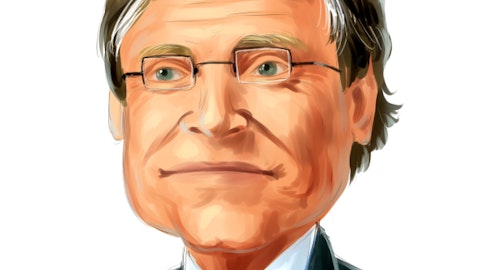Doug MacDonald: We – I mean, thanks, Dave. Yes, I mean we have these customer initiatives. If these customer initiatives, some of them fall off the table or some of them have been later, then obviously, we will regulate our CapEx accordingly. I mean the capital envelope is a living thing. It’s a dynamic thing. We look at it on a regular basis. So obviously, absolutely, we will look at our CapEx in light of those opportunities coming on board.
David Vernon: Thank you.
Operator: Our next question comes from Konark Gupta from Scotiabank. Please go ahead. Your line is open.
Konark Gupta: Thanks for taking my question. Echo my congratulations to Ed, Patrick and Derek. Perhaps on international intermodal side, I want to figure out what’s your visibility on timing for when the container traffic fully returns back to Canada from the U.S. And then as a follow-up on domestic intermodal, can you talk about the RFPs you’re expecting in terms of size or nature for Falcon premium? Thanks.
Ed Harris: Okay. Thanks, Konark. So on the international side, our customers are telling us they see a gradual ramp up over the next year or so. So we’re expecting that. That’s what’s in our forecast and our outlook moving forward. And that’s the best visibility we have in the market. So, we’re depending upon them, and we think it’s right. On the domestic side, outside of – so on the domestic Canadian side, things are going very well. We’re actually seeing increases there year-over-year, which is fantastic. So that market has come back – coming back nicely. We see some green shoots there. On the Falcon, we’re seeing RFPs on a regular basis. Now the customers have to be able to trust us and do it. So we’re getting – we’re out there getting trials with them and things like that.
It’s going to take a while to build this off the road. At the same time, we know truck rates in the U.S. have been depressed over the last year, and we’re competing against those as we move forward. We do have a great product, and we know we’re going to win as time moves on.
Konark Gupta: Thank you.
Operator: Our next question comes from Fadi Chamoun from BMO. Please go ahead. Your line is open.
Fadi Chamoun: Thank you, Ed, Pat and Derek, congrats on the role. And Ed, this is truly a last retirement, all the best, and thanks for all the advice over the years. Maybe, Doug, on the fourth quarter, if you can give us – what are you assuming for volume in the fourth quarter in terms of growth year-on-year or sequentially? Just to kind of help us track your progress on that front? And my question on the cost per head count per employee? Like, how should we think about this sequentially into Q4? And I know you have some labor negotiations coming up here. And how do you think about the best way for us to think about that cost per headcount in 2024?
Tracy Robinson: Listen, Fadi I’m going to take the first one, and I’ll hand it off to Ghis for the second one. So as we’re looking at volumes, kind of, week-over-week and month-over-month, we’re seeing that sequential strength. And right now, we’re looking at sequential growth in all but kind of the international, even in the international volumes sequentially, though we’re seeing real strength coming from most, if not all of our business lines as you look at it sequentially over time. So we’ve mapped that out, does pretty close to its customers and what they’re planning over the course of this year. So it’s on that basis that our confidence remains on our guidance. And if you look at industrial production as well, we’ve said that we were going to do better than industrial production. Industrial production is strengthening. And I think that Doug what do you think, you’ll see us do that on everything, maybe except the international lines. Would that be the case?
Doug MacDonald: No, I agree with that 100%, Tracy.
Tracy Robinson: Okay. Thank you. Ghis.
Ghislain Houle: Yes. So Fadi, on the average comp per employee, when you look at it sequentially, it’s up 2% in Q3 versus Q2, and that’s mostly due to a 4% wage increase on our U.S. employees that started in July 2023. And for next year, I mean, again, I would continue to assume regular wage increases and we’re just replacing employees for attrition, and that’s about it. So that’s the answer to that question.
Fadi Chamoun: Thank you.
Ghislain Houle: Thank you.
Operator: Our next question comes from Ken Hoexter from Bank of America. Please go ahead. Your line is open.
Ken Hoexter: Great, good afternoon. I’ll stick to it. Congrats on your last call and your attempt on the fifth retirement and congrats to Derek and Pat, which is great, as Tracy said, they have no mic. So Tracy, you can really talk about them now.
Tracy Robinson: That’s right, Ken. I can.
Ken Hoexter: I guess just a numbers question real quick and then a long-term one. The casualty costs, they ramped up in the quarter. I just want to understand, is that sticky? Or is that just because I think it was mentioned there were a couple of extra accidents in the quarter. But long-term, my question would be just on – I know you’ve talked a little bit about the 10% to 15%. I know that’s not linear. But how should we think about that as you start to rebound? And maybe give us upside downside. Is it just the volume because Doug sounds like you’ve got a lot of confidence that we passed the bottom. So is that just moving past the storms and the U.S. grain crop bouncing up? Maybe talk about the upside, downside on that range for next year.
Doug MacDonald: Yes, Ken, maybe the first – your first question on the casualty cost. I mean, I’m looking at my notes here. I mean, C&O, Casualty & Other is mostly flat on a year-over-year basis in the quarter. So I’m not sure what number you’re looking at.
Ken Hoexter: I just looked at it was just up sequentially, right? So I know year-over-year. Is that just – is that seasonal in terms of the actions it ran up?
Doug MacDonald: Okay. Sequentially, it’s again, it’s just up about 6%, 7%, and it’s really lower horsepower – high horsepower income. This is tough to say for a French guidance. So it’s just mostly lower high horsepower income in Q3 versus Q2.
Ken Hoexter: Okay, yes. If it’s not a trend, that’s fine. I just want to make sure if that was nothing that was sticky based on…
Doug MacDonald: We true up on our horsepower every quarter, so you have some ups and downs depending on how we interchange our trains with other roads and so on and so forth.
Ken Hoexter: Okay. Perfect.
Tracy Robinson: Then on the volume question, so you’re right, we don’t see this as being linear. And what we did put together was kind of – last year was kind of a 10-year view on what our growth would look at what we put in front of you guys in – earlier this year was the three-year view on that. And so a good chunk of that, as we’ve said. Are a number of customer initiatives that Doug is working and that’s not a static list, it moves around a lot. And I’m excited about some of the new ones that are coming on of that list. What remains uncertain is the other part of it, which is the volume growth that’s going to come with our customers and our partners on just the economic strength. And so we’re modeling in kind of what we’ve talked to you about next year.
We’ll give you a little bit kind of related to industrial production. We’ll give you a little bit more color on that in January when we talk to you next. But I would say that, that would be the biggest risk for next year.




